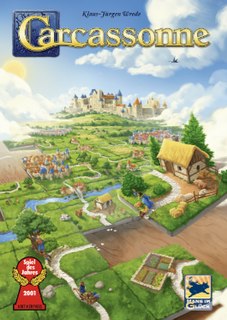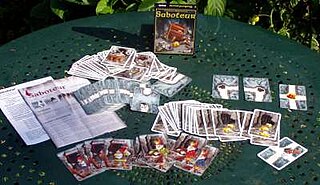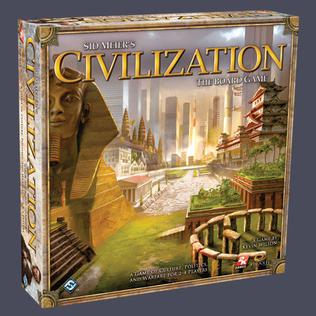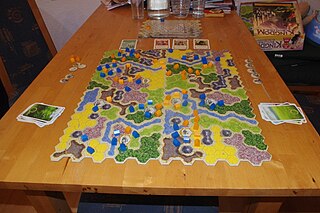
Catan: Seafarers, or Seafarers of Catan in older editions, is an expansion of the board game Catan for three to four players. The main feature of this expansion is the addition of ships, gold rivers, and the pirate to the game, allowing play between multiple islands. The expansion also provides numerous scenarios, some of which have custom rules. The Seafarers rules and scenarios are also, for the most part, compatible with Catan: Cities & Knights and Catan: Traders & Barbarians.

Carcassonne is a tile-based German-style board game for two to five players, designed by Klaus-Jürgen Wrede and published in 2000 by Hans im Glück in German and by Rio Grande Games and Z-Man Games (currently) in English. It received the Spiel des Jahres and the Deutscher Spiele Preis awards in 2001.
A Game of Thrones: The Card Game is an out-of-print collectible card game produced by Fantasy Flight Games. It is based on A Song of Ice and Fire, a series of novels written by George R. R. Martin. The first set was Westeros Edition and was released in August 2002. It has since won two Origins Awards. The game's primary designer is Eric Lang, the lead developer is Nate French, with Damon Stone serving as associate designer.
In tabletop games and video games, game mechanics are the rules that govern and guide the player's actions, as well as the game's response to them. A game's mechanics thus effectively specifies how the game will work for the people who play it.
Zombies!!! is a tile-based strategy board game for two to six players. Zombies!!! won the 2001 Origins Award for Best Graphic Presentation of a Board Game, and Zombies!!! 3: Mall Walkers won 2003's Origins Award for Best Board Game Expansion.
Battle Masters is a board game by Milton Bradley made in collaboration with Games Workshop in 1992. It is a game that simulates the type of battles as seen in Warhammer Fantasy Battle, but with much simpler game mechanics not based on its parent game. The game, like its sibling Milton Bradley/Games Workshop partnerships HeroQuest and Space Crusade, was designed by Stephen Baker, who later went on to design the popular game Heroscape.
Betrayal at House on the Hill is a board game published by Avalon Hill in 2004, designed by Bruce Glassco and developed by Rob Daviau, Bill McQuillan, Mike Selinker, and Teeuwynn Woodruff. Players all begin as allies exploring a haunted house filled with dangers, traps, items, and omens. As players journey to new parts of the mansion, room tiles are chosen at random and placed on the game board; this means that the game is different each session. Eventually the "haunt" begins, with the nature and plot of this session's ghost story revealed; one player usually "betrays" the others and takes the side of the ghosts, monsters, or other enemies, while the remaining players collaborate to defeat them.

Challenge of the Ancient Empires!, also known as Ancient Empires is an educational computer game created by The Learning Company in 1990 for both MS-DOS and Macintosh. It is designed to improve history, logic, and problem solving skills in children ages 7 to 10.

Dungeon! is an adventure board game designed by David R. Megarry and first released by TSR, Inc. in 1975. Additional contributions through multiple editions were made by Gary Gygax, Steve Winter, Jeff Grubb, Chris Dupuis and Michael Gray. Dungeon! simulates some aspects of the Dungeons & Dragons (D&D) role-playing game, which was released in 1974, although Megarry had a prototype of Dungeon! ready as early as 1972.

Tsuro is a tile-based board game designed by Tom McMurchie, originally published by WizKids and now published by Calliope Games.
Catan Histories: Struggle for Rome is a 2006 German-style board game based on the game mechanics of Settlers of Catan, depicting the fall of the Western Roman Empire. The game is created by Klaus Teuber, the creator of Settlers, and is published under license from Catan GmbH by Kosmos in German and Mayfair Games in English. It is the second game in the Catan Histories series of board games. Often games produced in different languages by different publishers have slight rule differences between the versions. Catan Histories: Struggle for Rome is no exception.
Space Fleet is a board game for 2-4 players, published in 1991 by Games Workshop and designed by Jervis Johnson and Andy Jones.
Catan: Traders & Barbarians is the third expansion to the Settlers of Catan games, developed by Klaus Teuber. It contains a series of new scenarios and small variations, which are meant for two, three, or four players, with limited compatibility between the other two expansions, Catan: Seafarers and Catan: Cities & Knights. Three of the modules had been previously offered as "mini-expansions", though two have new rules in Traders. The expansion itself is named for one of the scenarios therein.

Saboteur is a mining-themed card game, designed by Frederic Moyersoen and first published in 2004.
Realm of the Jade Goddess is a German-style board game designed by Klaus Teuber and published in 2007 by Kosmos in Germany. It was originally available in limited release, and there has been no plans to release an edition for other languages.
Saboteur 2 is a mining-themed card game, designed by Frederic Moyersoen and published in 2011 by Z-Man Games. It is the sequel to Saboteur.

Sid Meier's Civilization: The Board Game is a 2010 board game created by Kevin Wilson based on the Sid Meier's Civilization series of video games and published by Fantasy Flight Games. While the previous board game based on Sid Meier's Civilization, published by Eagle Games in 2002, was based on Civilization III, the 2010 version takes its primary inspiration from Civilization IV. Its expansions, Fame and Fortune and Wisdom and Warfare, also began to incorporate concepts derived from Civilization V.

Kingdom Builder is a strategy board game designed by Donald X. Vaccarino, published in 2011 by Queen Games with illustrations by Oliver Schlemmer in German, British and international versions. A Finnish-Swedish version was released in 2012 by lautapelit.fi.

Splendor is a multiplayer card-based board game, designed by Marc André and illustrated by Pascal Quidault. It was published in 2014 by Space Cowboys, Asmodee. Players are gem merchants of the Renaissance, developing gem mines, transportation, and shops to accumulate prestige points. Spelendor received positive reviews and received numerous awards, including winner of Golden Geek Best Family Board Game, and nominated for the Spiel des Jahres Game of the Year in 2014. The game also received a mobile application and an expansion released in 2017.
The Genius: Black Garnet is the third season of The Genius. It debuted on tvN on October 1, 2014.









